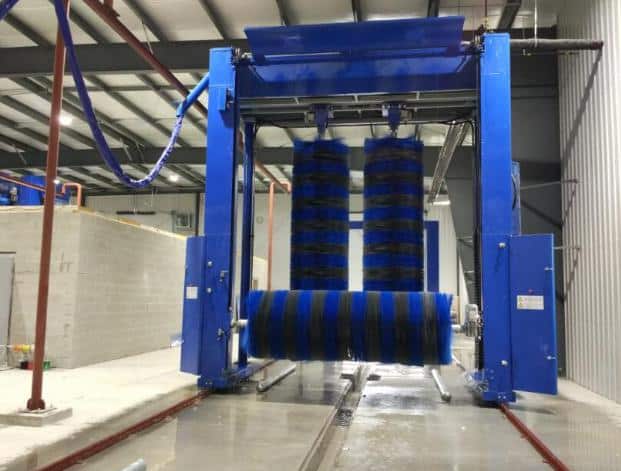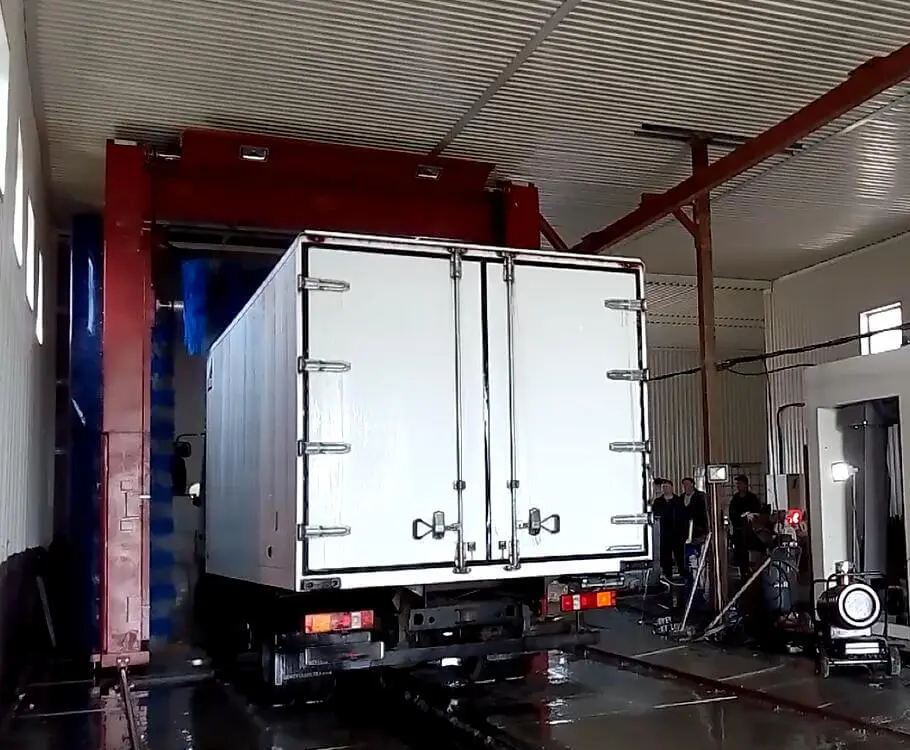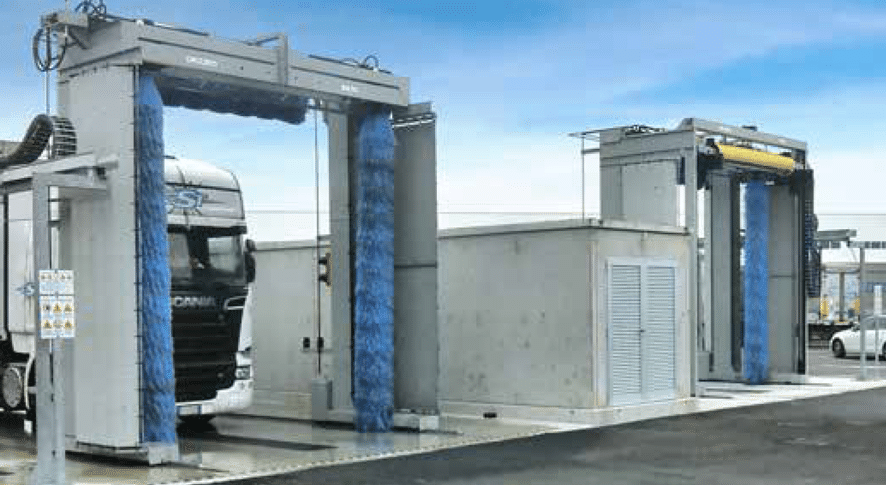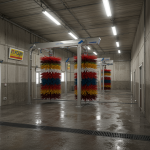Having a well-maintained fleet is paramount for any business in the transportation industry. Whether you operate a bus company or manage a fleet of tractor trailers, keeping your vehicles clean is not only important for aesthetics but also for the overall functionality and longevity of your assets. That’s where a 3-brush gantry bus or tractor trailer wash comes into play.
In this comprehensive article, we will delve into the components of a 3-brush gantry bus or tractor trailer wash, exploring how each component contributes to an efficient and effective cleaning process. From the gantry system that positions the brushes to the high-pressure water jets that blast away even the toughest grime, we will break down the entire wash system step by step.
By gaining a detailed understanding of how a 3-brush gantry bus or tractor trailer wash works, you can significantly enhance your fleet maintenance practices. Join us as we take a closer look at this essential cleaning equipment and discover how it can revolutionize the way you care for your vehicles.
Importance of regular vehicle washing in fleet maintenance
Maintaining a clean fleet goes beyond mere aesthetics. Regular vehicle washing is crucial for fleet maintenance as it helps prevent corrosion, improves fuel efficiency, and extends the lifespan of your vehicles.
Corrosion is one of the main concerns for any fleet owner. Road salt, chemicals, and other environmental contaminants can accumulate on the surface of your vehicles, leading to rust and deterioration. A 3-brush gantry bus or tractor trailer wash effectively removes these contaminants, protecting your fleet from corrosion and expensive repairs.
Furthermore, keeping your vehicles clean can significantly improve fuel efficiency. When dirt, grime, and debris accumulate on the surface of your vehicles, they create drag, increasing fuel consumption. By regularly washing your fleet with a 3-brush gantry system, you can reduce drag and improve your fuel efficiency, ultimately saving on operational costs.
Lastly, regular washing helps extend the lifespan of your vehicles. Removing dirt, salt, and other corrosive substances from your fleet’s exterior prevents damage to the paint, undercarriage, and other critical components. By investing in a 3-brush gantry bus or tractor trailer wash, you are investing in the longevity of your assets and reducing the need for early replacements.
Overview of a 3-brush gantry bus or tractor trailer wash
Before we dive into the components of a 3-brush gantry wash, let’s take a moment to understand how this system works. A 3-brush gantry bus or tractor trailer wash is an automated cleaning system specifically designed to efficiently clean large vehicles. It typically consists of a gantry system, brushes, high-pressure water jets, and cleaning agents.
The gantry system is the backbone of the wash system. It positions and moves the brushes along the length and height of the vehicle, ensuring thorough cleaning. The brushes themselves have soft bristles that are gentle on the vehicle’s surface while effectively removing dirt and grime. High-pressure water jets are strategically placed to blast away tough stains and debris.
To enhance the cleaning process, specialized cleaning agents and solutions are used. These solutions are specifically formulated to remove grease, oil, and other stubborn substances commonly found on commercial vehicles. The combination of brushes, water jets, and cleaning agents ensures a thorough and efficient cleaning process for your fleet.

Components of a 3-brush gantry bus or tractor trailer wash
Now, let’s take a closer look at the individual components that make up a 3-brush gantry bus or tractor trailer wash.
1. Gantry System: The gantry system is the framework that supports and moves the brushes along the length and height of the vehicle. It is typically made of sturdy materials like stainless steel or aluminum to withstand heavy use and provide stability during the cleaning process.
2. Brushes: The brushes are the heart of the wash system. They are designed with soft bristles that effectively remove dirt and grime without scratching or damaging the vehicle’s surface. The number of brushes may vary, but a 3-brush system is commonly used for large vehicles like buses or tractor trailers.
3. High-Pressure Water Jets: High-pressure water jets play a crucial role in removing tough stains, debris, and contaminants from the vehicle’s exterior. These jets are strategically placed to cover all areas of the vehicle, ensuring a thorough and efficient cleaning process. The high-pressure water helps dislodge even the most stubborn dirt and grime.
4. Cleaning Agents and Solutions: To enhance the cleaning process, specialized cleaning agents and solutions are used. These solutions are specifically formulated to remove grease, oil, and other stubborn substances commonly found on commercial vehicles. The cleaning agents work in conjunction with the brushes and water jets to ensure a deep and effective clean.

By understanding the purpose and function of each component, you can appreciate the effectiveness and efficiency of a 3-brush gantry wash system. This knowledge will empower you to make informed decisions regarding your fleet maintenance practices.
Cleaning agents and solutions used in a 3-brush gantry wash
The cleaning agents and solutions used in a 3-brush gantry wash system are specifically formulated to tackle the unique challenges of cleaning commercial vehicles. These solutions are designed to remove grease, oil, road tar, and other stubborn substances commonly encountered in the transportation industry.
One common cleaning agent used in a 3-brush gantry wash system is a degreaser. Degreasers are formulated to break down and dissolve grease and oil, making them highly effective in removing stubborn stains from the surface of your vehicles. These degreasers are typically safe to use on a variety of surfaces, including paint, metal, and rubber.
In addition to degreasers, alkaline-based cleaning solutions are often used. These solutions are highly effective in removing road tar, brake dust, and other tough contaminants. Alkaline cleaners work by breaking down the chemical bonds of these substances, allowing them to be easily washed away by the brushes and water jets.
It’s important to note that while these cleaning agents are highly effective, they should be used in the recommended concentrations and according to the manufacturer’s instructions. Using too much or too little cleaning agent can affect the cleaning performance and potentially damage the vehicle’s surface. Therefore, it’s crucial to follow the guidelines provided by the manufacturer of the cleaning agents to ensure optimal results.
By utilizing the right combination of cleaning agents and solutions, you can achieve a deep and thorough clean for your fleet, removing even the toughest stains and contaminants. This will not only enhance the appearance of your vehicles but also contribute to their overall functionality and longevity.
Benefits of using a 3-brush gantry wash for fleet maintenance
Investing in a 3-brush gantry bus or tractor trailer wash offers numerous benefits for fleet maintenance. Let’s explore some of the key advantages that this system provides:
1. Efficiency: A 3-brush gantry wash system is designed to clean large vehicles quickly and efficiently. The automated nature of the system ensures consistent cleaning results, reducing the time and effort required compared to manual washing methods. This increased efficiency allows you to clean your fleet more frequently, leading to improved maintenance practices.
2. Thorough Cleaning: The combination of brushes and high-pressure water jets in a 3-brush gantry wash system ensures a thorough cleaning of your vehicles. The brushes effectively remove dirt and grime from the surface, while the water jets blast away tough stains and debris. This comprehensive cleaning process leaves your fleet looking pristine and well-maintained.
3. Consistency: Manual washing methods can vary in terms of quality and results, depending on the individual performing the task. With a 3-brush gantry wash system, you can expect consistent cleaning results every time. The automated system ensures that each vehicle is cleaned in the same manner, eliminating the inconsistencies that may arise from manual washing.
4. Convenience: Operating a 3-brush gantry wash system is relatively easy and requires minimal training. Once the system is set up and programmed, it can be operated by a single individual, freeing up your workforce for other tasks. Additionally, the automated nature of the system allows for unattended operation, saving you time and resources.
5. Long-Term Cost Savings: While investing in a 3-brush gantry wash system may require an upfront investment, it can lead to significant long-term cost savings. Regular cleaning with this system helps prevent corrosion, reducing the likelihood of expensive repairs or premature replacements. Moreover, improved fuel efficiency resulting from cleaner vehicles can lead to substantial savings in operational costs over time.
By incorporating a 3-brush gantry wash system into your fleet maintenance practices, you can enjoy these benefits and ensure that your vehicles are always clean, well-maintained, and ready for the road.
Maintenance and troubleshooting of a 3-brush gantry wash system
To ensure the optimal performance and longevity of your 3-brush gantry wash system, regular maintenance and troubleshooting are essential. Here are some key maintenance tasks and troubleshooting tips to keep your system running smoothly:
1. Regular Cleaning and Inspection: Clean the brushes, gantry system, and water jets regularly to remove any dirt, debris, or buildup that may affect the performance of the system. Inspect the brushes for wear and tear and replace them if necessary. Additionally, check the gantry system for any loose or damaged parts and repair or replace them as needed.
2. Monitor Water Pressure and Flow: Proper water pressure and flow are crucial for the effective operation of a 3-brush gantry wash system. Regularly check the water pressure and flow rate to ensure they are within the manufacturer’s recommended range. Adjustments may be necessary if there are any deviations from the desired specifications.
3. Monitor Cleaning Agent Levels: If your 3-brush gantry wash system incorporates the use of cleaning agents, regularly monitor the levels to ensure an adequate supply. Refill the cleaning agent reservoirs as needed to maintain optimal cleaning performance. Follow the manufacturer’s guidelines for the appropriate concentration and usage of the cleaning agents.
4. Address Mechanical Issues Promptly: If you encounter any mechanical issues or malfunctions with your 3-brush gantry wash system, address them promptly to prevent further damage. Consult the manufacturer’s documentation or contact their customer support for guidance on troubleshooting and repairs.
5. Employee Training: Properly train your employees on the operation and maintenance of the 3-brush gantry wash system. Ensure they are familiar with the system’s controls, safety procedures, and maintenance tasks. Regularly provide refresher training to reinforce best practices and address any new developments or updates.
By following these maintenance and troubleshooting guidelines, you can maximize the lifespan and performance of your 3-brush gantry wash system, ensuring that it continues to deliver optimal cleaning results for your fleet.
Comparison of different types of vehicle wash systems
While a 3-brush gantry wash system offers numerous benefits for fleet maintenance, it’s essential to consider other types of vehicle wash systems to make an informed decision for your specific needs. Here, we’ll compare the 3-brush gantry wash system with other common types of vehicle wash systems:
1. Touchless Wash Systems: Touchless wash systems use high-pressure water jets and specialized cleaning agents to clean vehicles without physical contact. These systems are gentle on the vehicle’s surface and are effective in removing dirt and grime. However, they may not be as efficient in removing stubborn stains or heavy debris compared to a 3-brush gantry wash system.
2. Brushless Wash Systems: Brushless wash systems utilize high-pressure water jets and rotating nozzles to clean vehicles. These systems are effective in removing dirt and grime and are generally faster than touchless systems. However, they may not offer the same level of thorough cleaning as a 3-brush gantry wash system, especially when it comes to removing stubborn stains or debris.
3. Manual Washing: Manual washing involves physically scrubbing the vehicle’s surface using brushes, sponges, or other cleaning tools. While manual washing allows for precise control and attention to detail, it is time-consuming and labor-intensive. Additionally, manual washing may not be as consistent or efficient as automated systems like the 3-brush gantry wash system.
Ultimately, the choice of the vehicle wash system depends on various factors, including the size of your fleet, the specific cleaning requirements, and your available resources. Consider the advantages and limitations of each system before making a decision. Consulting with industry experts or experienced fleet managers can provide valuable insights to help you make an informed choice.
Choosing the right 3-brush gantry wash system for your fleet
Selecting the right 3-brush gantry wash system for your fleet is crucial to ensure optimal cleaning performance and efficiency. Here are some factors to consider when choosing a system:
1. Vehicle Size and Capacity: Determine the system’s compatibility with your fleet’s size and the types of vehicles you operate. Consider the height, length, and weight capacity of the system to accommodate your largest vehicles.
2. Cleaning Performance: Evaluate the cleaning performance of the system. Look for a system that offers thorough cleaning, effective removal of tough stains, and efficient use of cleaning agents. Request demonstrations or references to gauge the system’s effectiveness.
3. Durability and Maintenance: Consider the durability and maintenance requirements of the system. Look for systems made of high-quality materials that can withstand heavy use. Additionally, inquire about the recommended maintenance tasks and frequency, as well as the availability of spare parts.
4. Automation and Features: Assess the level of automation and additional features offered by the system. Look for systems with programmable controls, adjustable brushes, and customizable cleaning settings to cater to your fleet’s specific needs.
5. Manufacturer Reputation and Support: Research the reputation and track record of the manufacturer. Look for reliable manufacturers with a proven history of producing quality wash systems. Additionally, consider the availability of customer support, warranties, and maintenance services.
By considering these factors and thoroughly evaluating the available options, you can choose a 3-brush gantry wash system that meets your fleet’s unique requirements and enhances your fleet maintenance practices.




